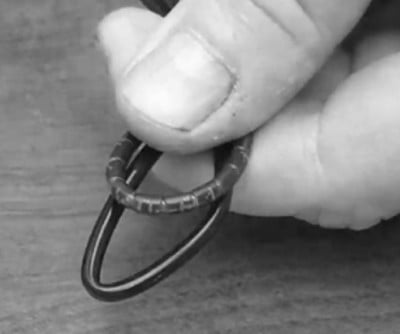 There is a limit to the bending ratio or tight diameter in a microduct or fiber cable - after which, the fiber starts to exhibit failure. The failure can be a slight increase in insertion loss or a "kink" in the fiber that creates a catastrophic effect.
There is a limit to the bending ratio or tight diameter in a microduct or fiber cable - after which, the fiber starts to exhibit failure. The failure can be a slight increase in insertion loss or a "kink" in the fiber that creates a catastrophic effect.
One of the challenges of installing fiber in the last drop of an FTTH network is knowing the overall distance and the amount of 90° angles you can have in the path you will be using. Distance and 90° turns create additional friction and add to the cumulative friction.
How to Determine Proper Bend Radius
Maintaining proper bend radius is important in preventing service calls due to damage and signal loss in your optical fiber. Bend radius is the curvature an optical fiber can bend without damage or shortening its lifespan via kinking. The smaller the rated bend radius, the more flexible the fiber. If no recommendations are available from the cable manufacturer, the cable should not be pulled into a bend radius smaller than 20 times the cable diameter.
For example, a cable with an outer diameter of 5mm, should not be bent smaller than 100mm radius during installation. After completion of the pull, the cable should not have any bend radius smaller than 10 times the cable diameter. When a fiber cable is bent excessively, the optical signal within the cable may refract and escape through the fiber cladding. Bending can also permanently damage the fiber by causing micro-cracks.
Note that one fiber kinks and the other does not - check the manufacturer’s spec for bend radius.
The result of kinking the fiber is known as bend loss: a loss of signal strength that may compromise the integrity of the data transmission.
There are a couple of factors that may mitigate the problems of bend radius and the angles within them. If a fiber cable is being pulled or pushed through an empty duct or mini-duct, obviously there is less resistance to the cable and you can pull/push greater distances. If the coating of the outside of the cable and the inside of the duct are designed to reduce friction, you will be able to achieve greater distances as well.
With well-designed pushable fiber and low friction microduct, you can usually push a fiber cable as far as 300 feet when there are five or less 90 degree angles in the run.
Tensile Strength for Pulling Fiber Cable
If the cable is being installed within a microduct or conduit, pushing the cable will apply no tensile force. However, if the cable is being pulled through, the maximum tensile load needs respecting.
Over-stressing the fibers will not be noticeable until after installation since the cable outer sheath will elongate, whereas glass optical fiber will not.
Ideally, a breakaway swivel should be used - however, where this is not possible, the installation crews should use a tension gauge attached to the pull-cord. As a rough approximation, 100 Newtons is equivalent to a 22lbf (pounds-force) load applied directly to the cable.
Avoiding Kinks in Smaller Fibers
900µm fibers can easily be damaged with respect to storage/management. 900 µm kinks easily - but is very flexible and installs easily. Sometimes, you have to balance ease of installation with toughness. The image below shows a small fiber being kinked versus PPC's Miniflex® fiber cable.
 You may need a rugged, weather-resistant cable.
You may need a rugged, weather-resistant cable.
Once at the building, you must get the fiber through walls - possibly in basements, attics, or crawl spaces - and then through floors, walls and, eventually, through a room to the CPE location.
For rugged spaces where your fiber may suffer damage, such as basements or in conduits sharing space with electrical or other wiring, you may need a 3mm rugged sheathed cable that is flexible and crush resistant.
A good rule of thumb to use in planning your fiber drop is below:
Bends (angles) = Friction – maximum distance of the pushable fiber
In addition to the bend radius, here are some other areas to focus on to achieve maximum distance without damaging the cable:
- How congested is the path?
- Can redundant cables be removed first?
- Signal power and performance requirements for each device or revenue generating unit.
- Locations of required splices.
- List of cable lengths required.
Fiber is often installed through utility pathways, but these are often old, congested and may not even be properly mapped. When using duct or cable in conduit, keep in mind that freezing water in the conduit can crush the cable - and it may be wise to use microduct.
The full space in the duct is not usable for cables because of horizontal and vertical bends and joints. Usable duct space should be at least 60%.
Summary
Applications with and without duct are suited for both FTTP and in-building installations. When selecting the fiber to use for your installation, you need a cable with a very small bend radius, but that is tough enough to handle many different installation conditions.
Once you have selected the appropriate fiber, plan your route to minimize bends and friction. The last drop is the one that sees the most service calls due to damaged fiber - by planning ahead and thinking carefully, you can save money by reducing the costs of those service calls.




Comments